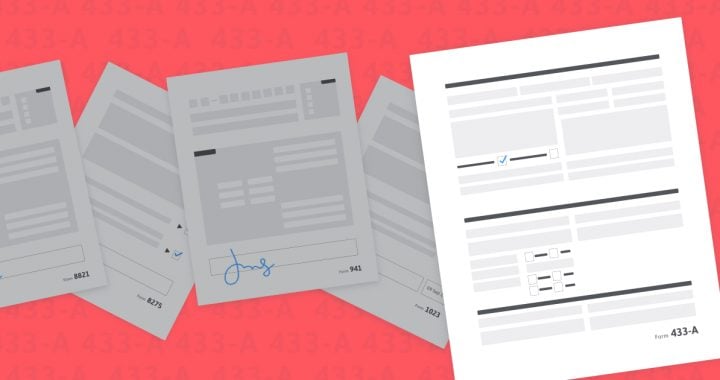Working on tax resolution cases can be tedious at times. The Internal Revenue Manual (IRM) has a lot of rules and guidelines to sort through, and it can become very time-consuming.
But what if there was a way to offer tax resolution to your clients without having to spend hours researching the IRM? The great news is: there is.
Canopy offers tax resolution software that automates the busywork, saving you tons of time. If you haven't yet experienced automation in your casework, your life is about to be changed. Automation makes working on tax resolution more efficient and manageable than ever before.
Here’s an overview of some of Canopy's automation features.
Filling out IRS forms
How it's normally done
You or your client schedule an appointment where you try to get as much information as possible, then you fill out all the required IRS forms (which inevitably contain a lot of repetitive information). Then, if one piece of information changes, you have to go back through each form and make that change manually.
How Canopy does it
You can ask your client to fill out a client survey within Canopy, so there's no need to schedule an appointment for them to come to your office. The client survey intuitively asks your client questions based on what they've already answered. They are never asked repeat or irrelevant questions. For example, if they indicate that they're single at the beginning of the survey, they won't have to answer any questions that are only applicable to married taxpayers. The information entered into the client survey will then auto-populate the necessary forms.
At any time, you can go into an IRS form and change information that’s been previously entered. You'll have a better chance for accuracy if you only have to fill out and check your information once instead of for every form.
Calculating collections cases
How it's normally done
To calculate a collections case such as Offer in Compromise without automated software, you have to look up a bunch of IRM guidelines for collections, then analyze the numbers to find the lowest offer amount, etc. Not to mention, collections cases can be very circumstantial, so you have to know how to proceed with each client's unique situation. If you don't know how to proceed, then you have to do more research.
How Canopy does it
Canopy's analytics tool uses the responses from the client survey to produce a recommendation for the best course of action for that case. You'll enter the amount owed in federal taxes, and Canopy will suggest the lowest offer amount for Offer in Compromise, plus show the potential savings from the offer. You’ll also be able to see what a recommended Installment Agreement would be and if your client is eligible for Currently Not Collectible status or not.
Additionally, any forms you need for the casework will already be filled out based on information you've already entered, and any needed addendums, down to the most nuanced details, will be automatically created and attached.
Finally, to help you refine your case before submitting it to the IRS, Canopy flags anything you need to fix or pay attention to before submitting.
Preparing Penalty Abatements, liens, levies, and more
How it's normally done
Similar to working on a collections case, working on other types of tax resolution cases demands a high level of knowledge of the IRM. You have to research the different guidelines for handling cases for services like Penalty Abatement, liens, levies, Innocent Spouse, etc.
How Canopy does it
Each time you start a service in Canopy, you can choose to get started with the assistant, which consists of answering a series of 10 questions or less about your client. If you don't know what a particular answer means, you can use drop-down arrows to see more information, ensuring you answer the questions correctly.
After the questions are answered, the assistant will give you a recommendation on how to proceed with the case. For example, at the end of the Penalty Abatement questions, the assistant may say something like "Penalty Relief Unlikely" or "Reasonable Cause Available." If you don't think the recommendation reflects the best outcome or you want to run a different scenario, you can choose to restart the assistant.
Canopy provides all the tools you'll need to handle your client's case in the most efficient way possible including:
- Templates for letters to the IRS
- An IRS phone discussion guide
- Required IRS forms
- Best practice suggestions
- IRS contact information
Client communication
How it's normally done
You know the drill of communicating with a client during their case. There are endless phone calls and emails. Your client asks you about the status of their case a lot. You repeatedly ask your client to send you required forms. Then, when it comes to getting paid, communication can become even more of an issue. You most likely have a client (or two, or 20!) who doesn't like to pay you on time.
How Canopy does it
Canopy offers several different features that facilitate client communication. For example, the client portal feature allows clients to see the status of their case, as well as exchange documents and forms with you. Client portals create transparency between you and your client and also improve efficiency. The less you’re calling, emailing, and meeting with a client to answer questions or request forms for their case, the more you can complete work on their case. You can even choose which sections of a client’s casework you allow them to view in their portal.
Hand in hand with client portals are client requests. Canopy will send automated requests and reminders to your clients based on the settings you've chosen. For example, if you wanted to send a daily reminder to a client to send in a certain form, you can automate that through client requests. The reminders will automatically stop when the request is fulfilled. You can even request and receive payment through Canopy.
Want to see all of these Canopy features for yourself? Sign up for a personalized demo.








Get Our Latest Updates and News by Subscribing.
Join our email list for offers, and industry leading articles and content.